Molecular Structure and GPR35 Receptor Docking of 1,3-Phenylene Bis-Oxalamide Derivatives
Abstract
:1. Introduction
2. Materials and Methods
2.1. Materials and Methods
2.2. Synthesis of Compounds
2.2.1. N1,N1′-(2,4,6-Trimethyl-1,3-phenylene)bis(N2-(2-morpholinoethyl)oxalamide) 3a
2.2.2. N1,N1′-(5-(Tert-butyl)-2-methoxy-1,3-phenylene)bis(N2-(2-(piperidin-1yl)ethyl)oxalamide) 3b
2.2.3. N1,N1′-(5-(Tert-butyl)-2-methoxy-1,3-phenylene)bis(N2-phenethyloxalamide) 3c
2.3. Molecular Docking Protocol
2.4. Single-Crystal X-Ray Diffraction
2.5. Hirshfeld Surface Analysis
3. Results and Discussion
3.1. Synthesis and Characterization of 3a–c
3.2. Crystal Structure of 3a–c
3.3. Hirshfeld Surface (HS) Analysis
3.4. Quantitative Interaction Energy Analysis and Energy Framework Diagrams
3.5. Molecular Docking Analysis
4. Conclusions
Author Contributions
Funding
Data Availability Statement
Acknowledgments
Conflicts of Interest
References
- MacKenzie, A.E.; Lappin, J.E.; Taylor, D.L.; Nicklin, S.A.; Milligan, G. GPR35 as a Novel Therapeutic Target. Front. Endocrinol. 2011, 2, 68. [Google Scholar] [CrossRef] [PubMed]
- Wu, Y.; Zhang, P.; Fan, H.; Zhang, C.; Yu, P.; Liang, X.; Chen, Y. GPR35 Acts a Dual Role and Therapeutic Target in Inflammation. Front. Immunol. 2023, 14, 1254446. [Google Scholar] [CrossRef] [PubMed]
- Shore, D.M.; Reggio, P.H. The Therapeutic Potential of Orphan GPCRs, GPR35 and GPR55. Front. Pharmacol. 2015, 6, 69. [Google Scholar] [CrossRef]
- MacKenzie, A.E.; Caltabiano, G.; Kent, T.C.; Jenkins, L.; McCallum, J.E.; Hudson, B.D.; Nicklin, S.A.; Fawcett, L.; Markwick, R.; Charlton, S.J.; et al. The Antiallergic Mast Cell Stabilizers Lodoxamide and Bufrolin as the First High and Equipotent Agonists of Human and Rat GPR35. Mol. Pharmacol. 2014, 85, 91–104. [Google Scholar] [CrossRef] [PubMed]
- Song, Z.; Lu, D.; Sun, J.; Ye, Y.; Fang, J.; Wang, K.; Guo, S.; Zhang, Q.; He, X.; Xie, X.; et al. Discovery of a Novel GPR35 Agonist with High and Equipotent Species Potency for Oral Treatment of IBD. Bioorg. Med. Chem. 2023, 96, 117511. [Google Scholar] [CrossRef]
- Cao, M.; Gao, Y. Mast Cell Stabilizers: From Pathogenic Roles to Targeting Therapies. Front. Immunol. 2024, 15, 1418897. [Google Scholar] [CrossRef]
- González-González, J.S.; Martínez-Martínez, F.J.; Peraza-Campos, A.L.; Rosales-Hoz, M.d.J.; García-Báez, E.V.; Padilla-Martínez, I.I. Supramolecular Architectures of Conformationally Controlled 1,3-Phenyl-Dioxalamic Molecular Clefts through Hydrogen Bonding and Steric Restraints. CrystEngComm 2011, 13, 4748–4761. [Google Scholar] [CrossRef]
- Pettersen, E.F.; Goddard, T.D.; Huang, C.C.; Couch, G.S.; Greenblatt, D.M.; Meng, E.C.; Ferrin, T.E. UCSF Chimera—A Visualization System for Exploratory Research and Analysis. J. Comput. Chem. 2004, 25, 1605–1612. [Google Scholar] [CrossRef]
- Schrödinger, L. Maestro, Version 13.3; Schödinger Release 2025-1; Schrödinger: New York, NY, USA, 2025. Available online: https://www.schrodinger.com (accessed on 25 February 2025).
- Duan, J.; Liu, Q.; Yuan, Q.; Ji, Y.; Zhu, S.; Tan, Y.; He, X.; Xu, Y.; Shi, J.; Cheng, X.; et al. Insights into Divalent Cation Regulation and G13-Coupling of Orphan Receptor GPR35. Cell Discov. 2022, 8, 135. [Google Scholar] [CrossRef]
- Dassault Systèmes. BIOVIA Discovery Studio Visualizer 2021; Dassault Systèmes: Paris, France, 2025; Available online: https://www.3ds.com/products/biovia (accessed on 25 February 2025).
- Bruker. APEX2, SAINT; Bruker AXS Inc.: Madison, WI, USA, 2006. [Google Scholar]
- Otwinowski, Z.; Minor, W. Processing of X-Ray Diffraction Data Collected in Oscillation Mode. In Methods in Enzymology; Elsevier: Amsterdam, The Netherlands, 1997; Volume 276, pp. 307–326. [Google Scholar] [CrossRef]
- Sheldrick, G.M. Crystal Structure Refinement with SHELXL. Acta Crystallogr. Sect. C Struct. Chem. 2015, 71, 3–8. [Google Scholar] [CrossRef]
- Macrae, C.F.; Bruno, I.J.; Chisholm, J.A.; Edgington, P.R.; McCabe, P.; Pidcock, E.; Rodriguez-Monge, L.; Taylor, R.; Van De Streek, J.; Wood, P.A. New Features for the Visualization and Investigation of Crystal Structures. J. Appl. Crystallogr. 2008, 41, 466–470. [Google Scholar] [CrossRef]
- Spek, A.L. PLATON SQUEEZE: A Tool for the Calculation of the Disordered Solvent Contribution to the Calculated Structure Factors. Acta Crystallogr. Sect. C Struct. Chem. 2015, 71, 9–18. [Google Scholar] [CrossRef] [PubMed]
- Farrugia, L.J. WinGX and ORTEP for Windows: An Update. J. Appl. Crystallogr. 2012, 45, 849–854. [Google Scholar] [CrossRef]
- Spackman, M.A.; Jayatilaka, D. Hirshfeld Surface Analysis. CrystEngComm 2009, 11, 19–32. [Google Scholar] [CrossRef]
- McKinnon, J.J.; Jayatilaka, D.; Spackman, M.A. Towards Quantitative Analysis of Intermolecular Interactions with Hirshfeld Surfaces. Chem. Commun. 2007, 37, 3814–3816. [Google Scholar] [CrossRef]
- Spackman, M.A.; McKinnon, J.J. Fingerprinting Intermolecular Interactions in Molecular Crystals. CrystEngComm 2002, 4, 378–392. [Google Scholar] [CrossRef]
- Spackman, P.R.; Turner, M.J.; McKinnon, J.J.; Wolff, S.K.; Grimwood, D.J.; Jayatilaka, D.; Spackman, M.A. CrystalExplorer: A Program for Hirshfeld Surface Analysis, Visualization and Quantitative Analysis of Molecular Crystals. J. Appl. Crystallogr. 2021, 54, 1006–1011. [Google Scholar] [CrossRef]
- Frisch, M.J.; Trucks, G.W.; Schlegel, H.B.; Scuseria, G.E.; Robb, M.A.; Cheeseman, J.R.; Scalmani, G.; Barone, V.; Mennucci, B.; Petersson, G.A.; et al. Gaussian 09, Revision, A.02; Gaussian, Inc.: Wallingford, CT, USA, 2009. [Google Scholar]
- Mackenzie, C.F.; Spackman, P.R.; Jayatilaka, D.; Spackman, M.A. CrystalExplorer Model Energies and Energy Frameworks: Extension to Metal Coordination Compounds, Organic Salts, Solvates and Open-Shell Systems. IUCrJ 2017, 4, 575–587. [Google Scholar] [CrossRef]
- Turner, M.J.; Thomas, S.P.; Shi, M.W.; Jayatilaka, D.; Spackman, M.A. Energy Frameworks: Insights into Interaction Anisotropy and the Mechanical Properties of Molecular Crystals. Chem. Commun. 2015, 51, 3735–3738. [Google Scholar] [CrossRef]
- Padilla-Martínez, I.I.; Martínez-Martínez, F.J.; Guillén-Hernández, C.I.; Chaparro-Huerta, M.; Cabrera-Pérez, L.C.; Gómez-Castro, C.Z.; López-Romero, B.A.; García-Báez, E.V. Switching from Twisted to Planar Oxamide Molecular Cavities through Intramolecular Three Centered Hydrogen Bonding. Arkivoc 2005, 2005, 401–415. [Google Scholar] [CrossRef]
- Zhao, P.; Lane, T.R.; Gao, H.G.L.; Hurst, D.P.; Kotsikorou, E.; Le, L.; Brailoiu, E.; Reggio, P.H.; Abood, M.E. Crucial Positively Charged Residues for Ligand Activation of the GPR35 Receptor. J. Biol. Chem. 2014, 289, 3625–3638. [Google Scholar] [CrossRef] [PubMed]
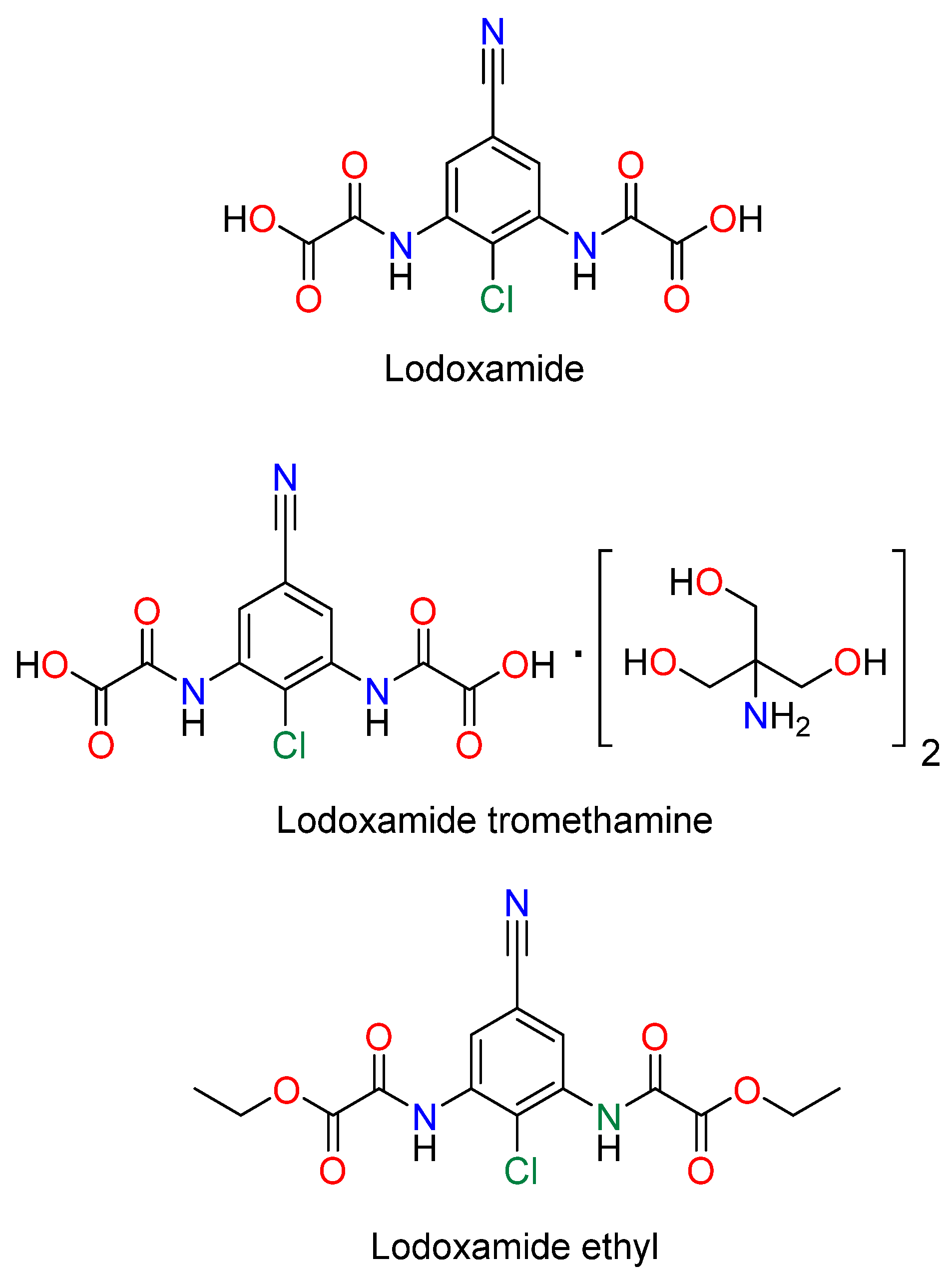

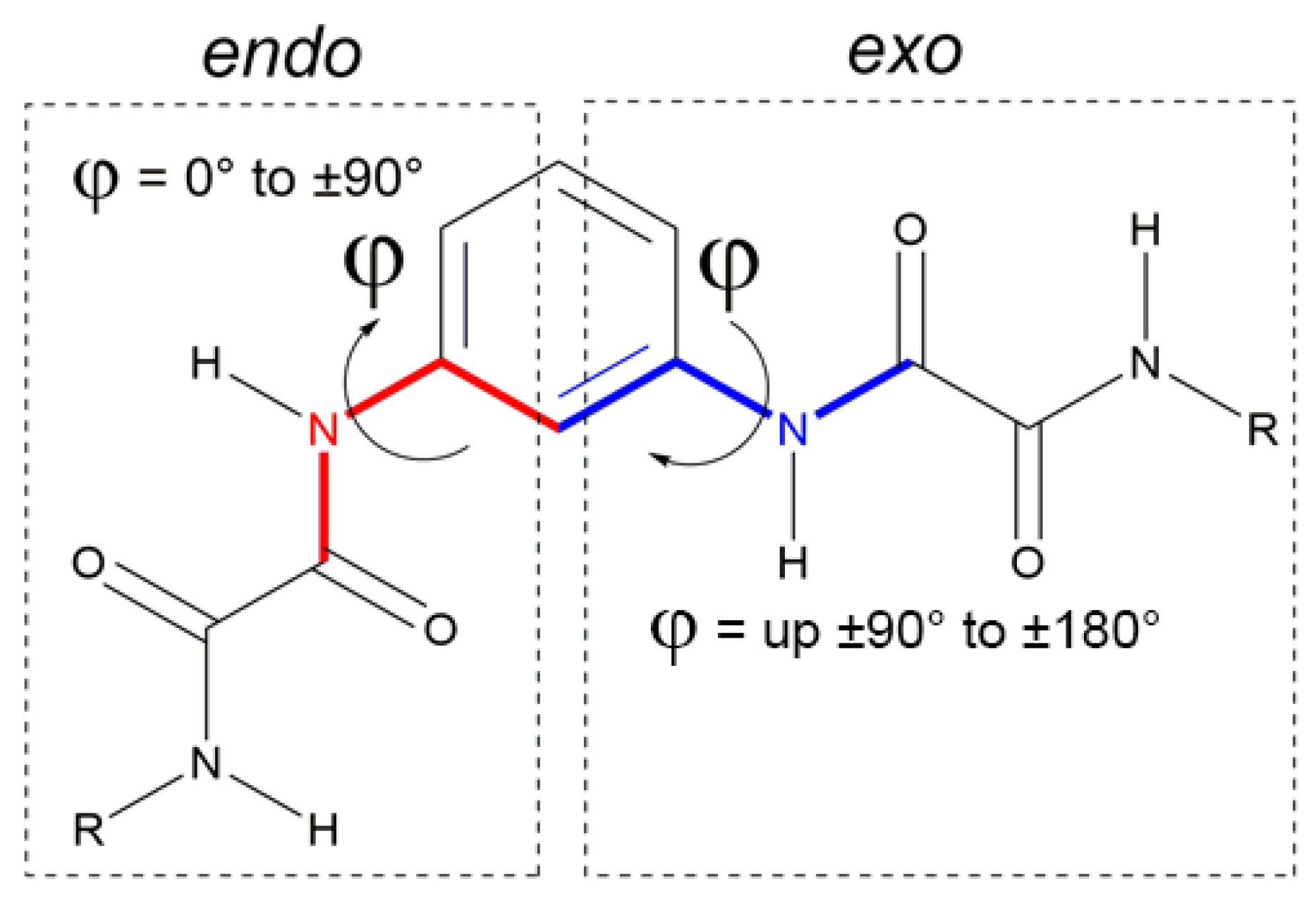


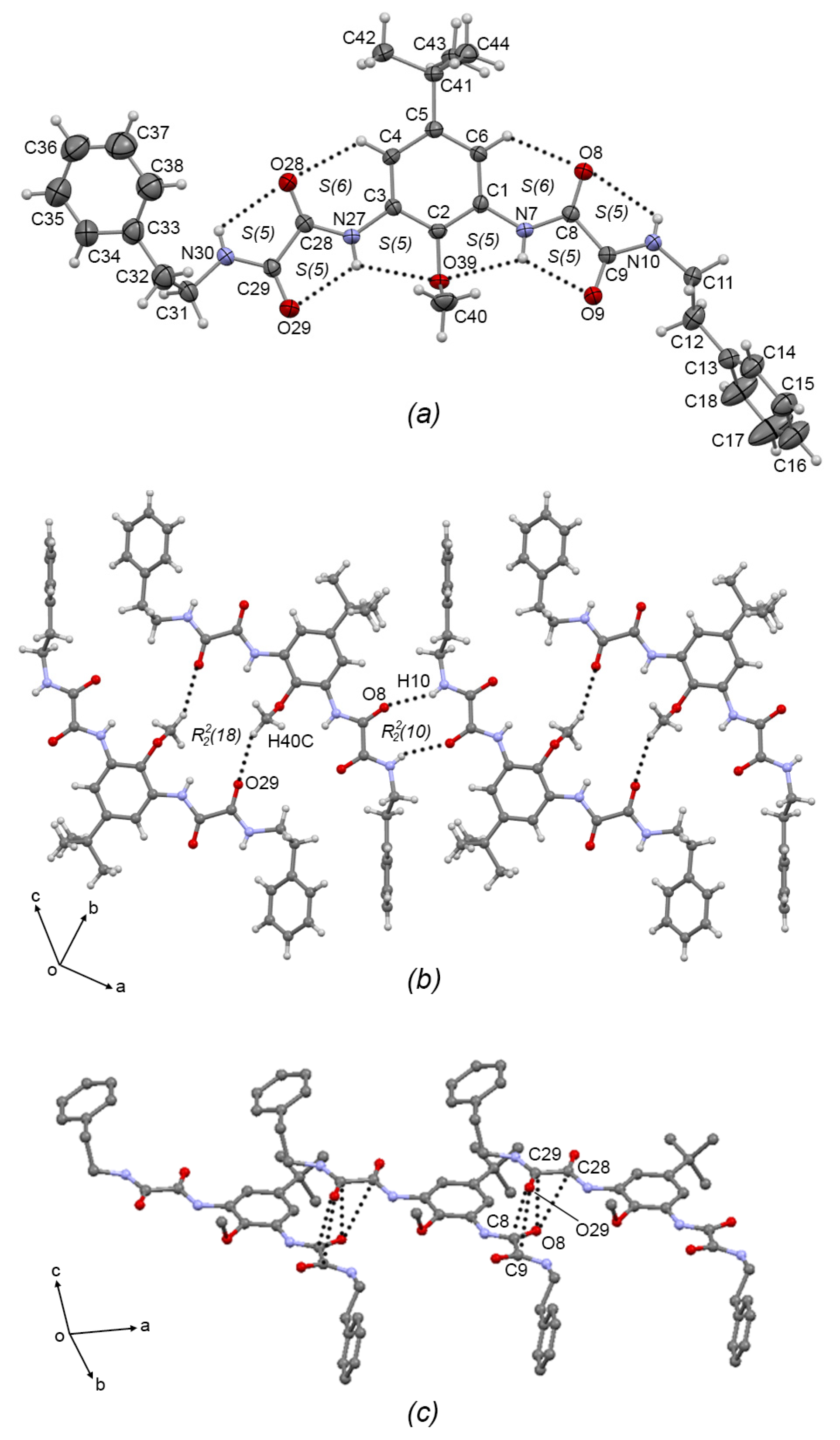
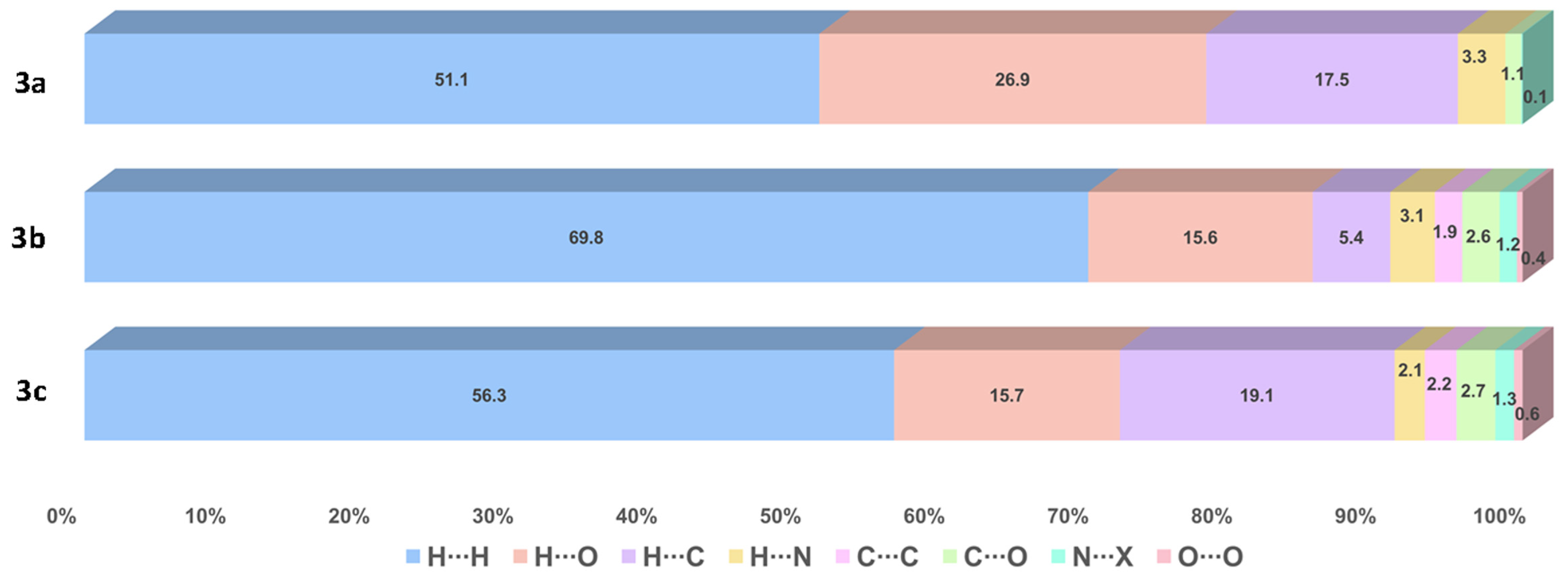


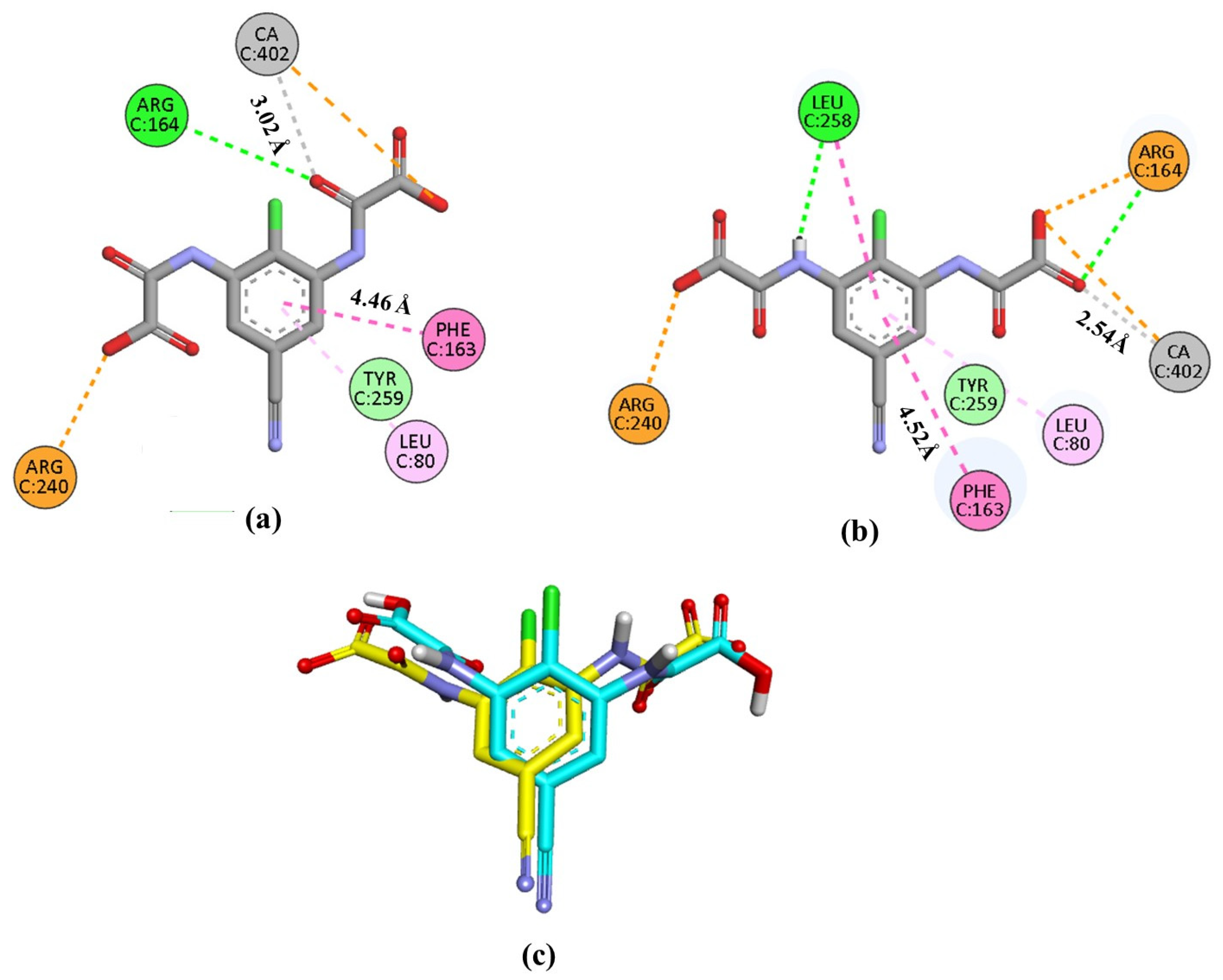

| 3a | 3b | 3c | |
|---|---|---|---|
| Crystal Data | |||
| Chemical formula | C25H38N6O6 | C29H46N6O5 | C31H36N4O5 |
| Mw/g mol−1 | 518.61 | 558.72 | 544.64 |
| Crystal system, space group | Monoclinic, C2/c | Triclinic, P-1 | Triclinic, P-1 |
| a, b, c (Å) | 24.772(6), 8.0171(19), 15.789(4) | 9.1930(5), 10.194(5), 16.8920(5) | 9.2580(6), 10.3050(6), 15.7970(6) |
| α, β, γ (°) | 125.836(3) | 101.205(5), 103.435(5), 98.086(5) | 92.554(5), 103.669(5), 106.186(5) |
| V (Å3) | 2542.1(11) | 1481.4(7) | 1396.48(14) |
| Z | 4 | 2 | 2 |
| Dx, g cm−3 | 1.355 | 1.248 | 1.295 |
| µ (mm−1) | 0.10 | 0.09 | 0.09 |
| Crystal size (mm) | 0.3 × 0.2 × 0.1 | 0.4 × 0.3 × 0.3 | 0.3 × 0.2 × 0.1 |
| Data Collection | |||
| Diffractometer | Bruker Apex II | Bruker Apex II | Kappa CCD |
| Radiation type | Mo Kα (λ = 0.71073) | Mo Kα (λ = 0.71073) | Mo Kα (λ = 0.71073) |
| No. of measured, independent and observed [I > 2σ(I)] reflections | 14,192, 3068, 2706 | 16,141, 5876, 3169 | 21,430, 4868, 3075 |
| Rint | 0.053 | 0.097 | 0.11 |
| Index ranges | −32 ≤ h ≤ 31, −10 ≤ k ≤ 10, −20 ≤ l ≤ 20 | −11 ≤ h ≤ 11, −12 ≤ k ≤ 12, −21 ≤ l ≤ 22 | −10 ≤ h ≤ 10, −12 ≤ k ≤ 12, −18 ≤ l ≤ 18 |
| Refinement | |||
| R[F2 > 2σ(F2)], wR(F2), S | 0.098, 0.199, 1.30 | 0.100, 0.321, 1.02 | 0.061, 0.174, 1.05 |
| No. of reflections | 3068 | 5876 | 4868 |
| No. of parameters | 170 | 377 | 381 |
| No. of restraints | 0 | 0 | 0 |
| Δρmax, Δρmin (e Å−3) | 0.55, −0.55 | 0.46, −0.55 | 0.33, −0.28 |
| 1H-NMR | |||||||||||
|---|---|---|---|---|---|---|---|---|---|---|---|
| H4,6 | H5 | H7 | H10 | H17 | H18 | H19 | H21 | ||||
| 3a a | --- | 7.00 | 10.18 | 8.69 | 1.91 | 2.09 | --- | --- | |||
| 3b b | 7.93 | --- | 9.87 | 8.94 | --- | --- | 3.75 | 1.27 | |||
| 3c c | 7.93 | --- | 9.87 | 9.20 | --- | --- | 3.74 | 1.27 | |||
| 13C-NMR | |||||||||||
| C1,3 | C2 | C4,6 | C5 | C8 | C9 | C17 | C18 | C19 | C20 | C21 | |
| 3a d | 132.9 | 129.3 | 134.5 | 132.9 | 159.6 | 160.5 | 14.2 | 18.5 | --- | --- | --- |
| 3b e | 116.0 | 147.5 | 130.0 | 142.6 | 158.5 | 160.1 | --- | --- | 61.6 | 35.1 | 31.6 |
| 3c f | 115.8 | 147.5 | 130.0 | 140.0 | 158.5 | 160.1 | --- | --- | 61.6 | 35.1 | 36.1 |
| D—H···A | D—H (Å) | H···A (Å) | D···A (Å) | D—H···A (°) |
|---|---|---|---|---|
| 3a | ||||
| N7—H7A···O9 | 0.86 | 2.34 | 2.72(3) | 107 |
| N10—H10A···O8 | 0.86 | 2.39 | 2.73(3) | 104 |
| 3b | ||||
| N7—H7···O2 | 0.85(5) | 2.26(5) | 2.71(5) | 114(4) |
| N7—H7···O9 | 0.85(5) | 2.26(5) | 2.64(5) | 108(4) |
| N7A—H7A···O2 | 0.79(5) | 2.38(5) | 2.73(5) | 108(4) |
| N7A—H7A···O9A | 0.79(5) | 2.21(5) | 2.64(5) | 115(4) |
| N10—H10···O8 | 0.69(7) | 2.46(6) | 2.72(5) | 105(5) |
| N10—H10···N13 | 0.69(7) | 2.53(6) | 2.84(6) | 111(6) |
| C4—H4···O8A | 0.93 | 2.31 | 2.93(5) | 124 |
| C6—H6···O8 | 0.93 | 2.34 | 2.94(5) | 122 |
| 3c | ||||
| N7—H7···O9 | 0.77(3) | 2.24(3) | 2.64(3) | 114(4) |
| N7—H7···O39 | 0.77(3) | 2.38(3) | 2.74(4) | 110(3) |
| N10—H10···O8 | 0.70(3) | 2.41(3) | 2.73(3) | 110(3) |
| N27—H27···O29 | 0.79(3) | 2.26(3) | 2.66(4) | 113(3) |
| N27—H27···O39 | 0.79(3) | 2.33(3) | 2.71(3) | 112(3) |
| N30—H30···O28 | 0.73(3) | 2.34(3) | 2.69(4) | 111(3) |
| C6—H19···08 | 0.93 | 2.32 | 2.93(4) | 123 |
| C4—H21···028 | 0.93 | 2.33 | 2.94(4) | 123 |
| D—H···A | Symmetry Code | D—H | H···A | D···A | D—H···A |
|---|---|---|---|---|---|
| 3a | |||||
| N7—H7A···O9 | −x, 2 − y, −z | 0.86 | 2.04 | 2.85(4) | 159 |
| N10—H10A··N13 | 1/2 − x, 1/2 + y, 1/2 − z | 0.86 | 2.14 | 2.94(5) | 155 |
| C14—H14B···Cg(2) | −x, 2 − y, −z | 2.84 | 171 | ||
| 3b | |||||
| N10A—H10A··O8A | 2 − x, 1 − y, −z | 0.86 | 2.22 | 3.00(5) | 152 |
| C19—H19B···O9 | −x, −y, −z | 0.96 | 2.51 | 3.45(5) | 165 |
| C12—H12D···Cg(3) | 1 + x, y, z | 2.68 | 165 | ||
| 3c | |||||
| N10—H10 ∙∙∙ O8 | 3 − x, 1 − y, −z | 0.70 | 2.34(3) | 2.98(4) | 155(3) |
| C40—H40C∙∙∙O29 | 1 − x, −y, −z | 0.96 | 2.46 | 3.32(4) | 150 |
| Motif | Interaction | −Eele | −Epol | −Edis | Erep | −Etot | %Eele a | %Edis a | R b/Å |
|---|---|---|---|---|---|---|---|---|---|
| 3a | |||||||||
| R22(10) | N7―H7∙∙∙O9 | 87.9 | 13.4 | 88.3 | 75.8 | 113.9 | 46.4 | 46.6 | 8.20 |
| 3b | |||||||||
| R22(10) | N10―H10∙∙∙O8 | 37.8 | 6.9 | 52.3 | 0.0 | 97.0 | 39.0 | 53.9 | 12.79 |
| Cg(3)∙∙∙Cg(3) c C44―H44C∙∙∙O9 Cg(3)∙∙∙C8O8 | 20.4 | 3.9 | 101.6 | 40.6 | 85.3 | 16.2 | 80.7 | 5.96 | |
| C17―H17A∙∙∙Cg(1) d | 25.4 | 3.3 | 82.0 | 31.0 | 79.7 | 22.9 | 74.1 | 7.24 | |
| C29―O29∙∙∙C9 C8―O8∙∙∙C29 C32―H32B∙∙∙Cg(3) c | 16.9 | 3.0 | 76.0 | 32.6 | 63.3 | 17.6 | 79.3 | 9.19 | |
| R22(18) | C40―H40A∙∙∙O29 | 25.3 | 3.6 | 43.0 | 22.9 | 49.0 | 35.1 | 59.8 | 8.18 |
| 3c | |||||||||
| R22(10) C(19) | N10―H10∙∙∙O8 C34―H34C∙∙∙Cg(2) e | 47.5 | 7.5 | 55.5 | 0.0 | 110.5 | 43.0 | 50.2 | 12.26 |
| C43―H43A∙∙∙O9 | 25.3 | 4.1 | 108.9 | 48.0 | 90.3 | 18.3 | 78.7 | 5.36 | |
| C15―H15∙∙∙Cg(1) f | 19.1 | 3.0 | 68.3 | 31.1 | 59.2 | 21.2 | 75.6 | 8.27 | |
| R22(18) | C40―H40C∙∙∙O29 | 28.9 | 4.9 | 48.4 | 22.6 | 59.5 | 35.1 | 58.9 | 8.07 |
| C29―O29∙∙∙C8 C8―O8∙∙∙C29 C31―H31B∙∙∙Cg(3) | 12.6 | 2.3 | 63.0 | 21.8 | 56.1 | 16.2 | 80.9 | 9.26 | |
| Compound | ΔG (kcal/mol) |
|---|---|
| 3a | −8.3 |
| 3b | −7.0 |
| 3c | −7.2 |
| Lodoxamide | −8.5 |
| Residue | Compound | |||
|---|---|---|---|---|
| Lodoxamide | 3a | 3b | 3c | |
| Val76 | --- | --- | Alkyl–alkyl | Alkyl–alkyl |
| Val77 | --- | --- | Alkyl–alkyl | Alkyl–alkyl |
| Leu80 | π–alkyl | π–alkyl | π–alkyl, alkyl–alkyl | π–alkyl, alkyl–alkyl |
| Tyr96 | --- | π–alkyl | --- | --- |
| Arg100 | --- | --- | --- | HB |
| Phe161 | --- | Carbon hydrogen bond | --- | --- |
| Phe163 | π–π stacked | π–π stacked | π–π stacked | π–π stacked |
| Arg164 | HB; electrostatic | --- | --- | --- |
| His168 | Carbon hydrogen bond | --- | Alkyl–alkyl | --- |
| Arg240 | Electrostatic | --- | --- | π–cation |
| Arg255 | --- | --- | Alkyl–alkyl | π–alkyl |
| Leu258 | HB; π–π stacked | π–alkyl | Alkyl–alkyl | π–alkyl |
| Tyr259 | --- | π–alkyl | --- | --- |
| Ser262 | --- | HB | HB | HB |
| Ca402 | Metal coordination; electrostatic | Metal coordination | Metal coordination | Metal coordination; π-cation |
Disclaimer/Publisher’s Note: The statements, opinions and data contained in all publications are solely those of the individual author(s) and contributor(s) and not of MDPI and/or the editor(s). MDPI and/or the editor(s) disclaim responsibility for any injury to people or property resulting from any ideas, methods, instructions or products referred to in the content. |
© 2025 by the authors. Licensee MDPI, Basel, Switzerland. This article is an open access article distributed under the terms and conditions of the Creative Commons Attribution (CC BY) license (https://creativecommons.org/licenses/by/4.0/).
Share and Cite
González-González, J.S.; Santiago-Quintana, J.M.; Madrigal-Angulo, J.L.; Barragán-Mendoza, L.; Magaña-Vergara, N.E.; García-Báez, E.V.; Padilla-Martínez, I.I.; Martínez-Martínez, F.J. Molecular Structure and GPR35 Receptor Docking of 1,3-Phenylene Bis-Oxalamide Derivatives. Crystals 2025, 15, 371. https://doi.org/10.3390/cryst15040371
González-González JS, Santiago-Quintana JM, Madrigal-Angulo JL, Barragán-Mendoza L, Magaña-Vergara NE, García-Báez EV, Padilla-Martínez II, Martínez-Martínez FJ. Molecular Structure and GPR35 Receptor Docking of 1,3-Phenylene Bis-Oxalamide Derivatives. Crystals. 2025; 15(4):371. https://doi.org/10.3390/cryst15040371
Chicago/Turabian StyleGonzález-González, Juan Saulo, José Martín Santiago-Quintana, José Luis Madrigal-Angulo, Lina Barragán-Mendoza, Nancy E. Magaña-Vergara, Efrén V. García-Báez, Itzia Irene Padilla-Martínez, and Francisco Javier Martínez-Martínez. 2025. "Molecular Structure and GPR35 Receptor Docking of 1,3-Phenylene Bis-Oxalamide Derivatives" Crystals 15, no. 4: 371. https://doi.org/10.3390/cryst15040371
APA StyleGonzález-González, J. S., Santiago-Quintana, J. M., Madrigal-Angulo, J. L., Barragán-Mendoza, L., Magaña-Vergara, N. E., García-Báez, E. V., Padilla-Martínez, I. I., & Martínez-Martínez, F. J. (2025). Molecular Structure and GPR35 Receptor Docking of 1,3-Phenylene Bis-Oxalamide Derivatives. Crystals, 15(4), 371. https://doi.org/10.3390/cryst15040371






